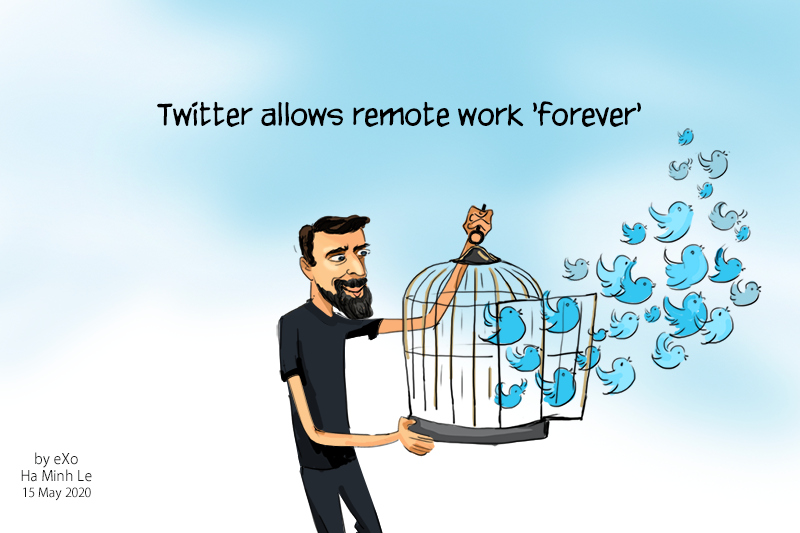
Remote work
The Ultimate Guide to Remote Work : definition, benefits, challenges and best practices
Remote work, also known as telecommuting or working from home, refers to a work arrangement where employees perform their job duties outside of the traditional office environment. Instead of commuting to a physical workplace, remote workers use technology and communication tools to carry out their tasks from their home, co-working spaces, or any other location of their choice.
It’s important to note that the experience of remote work can vary across industries, job roles, and individual preferences. Effective remote work requires clear communication, trust between employers and employees, and the use of appropriate tools and technologies to facilitate collaboration and productivity.
The concept of remote work has gained significant popularity and acceptance in recent years, driven by advancements in technology, changing work preferences, and the realization of its benefits for both employees and employers. It offers advantages such as increased flexibility, potential cost savings, access to a global talent pool, and reduced environmental impact. However, it also presents challenges related to communication, collaboration, and maintaining work-life balance, which need to be addressed effectively for successful remote work arrangements.
Related Posts :

FAQ
What is remote work?
What is the difference between telecommuting, working from home and working remotely?
Remote work refers specifically to the use of technology to work away from the office.
In essence, telecommuting emphasizes the use of telecommunications technology, working from home emphasizes the physical location of work (home), and working remotely encompasses any form of work outside of a traditional office setting, regardless of the specific location or technology used.
It’s important to note that the distinctions between these terms can vary depending on how they are used in different contexts, and the specific definitions may differ between organizations or individuals.
What are the benefits of remote working?
Remote working, like any work arrangement, comes with its benefits and disadvantages. Here are some of the key advantages of remote working:
- Flexibility
- Increased productivity
- Cost savings
- Access to a global talent pool
- Reduced environmental impact
How to improve the conditions for remote working?
Improving the conditions for remote working involves creating an environment and implementing strategies that support productivity, well-being, communication, and collaboration. Here are some key ways to enhance the conditions for remote working:
- Clear communication and expectations
- Provide necessary equipment and resources
- Support well-being and work-life balance
- Foster virtual collaboration and engagement
- Offer professional development opportunities
- Promote social interaction
- Provide regular feedback and recognition
- Encourage a healthy work environment
- Emphasize cybersecurity and data privacy
- Regularly review and adapt policies
By implementing these strategies and prioritizing the well-being, communication, collaboration, and professional growth of remote workers, organizations can improve the conditions for remote working and create a supportive and productive remote work environment.
What are the change management techniques
change management techniques refer to the strategies, processes, and tools that organizations use to prepare, plan, and manage changes effectively. Here are some common change management techniques:
- Communication: Effective communication is crucial during times of change. It helps ensure that all stakeholders are informed about the changes, understand the reasons behind them, and know what they need to do to support the change.
- Stakeholder engagement: Involve stakeholders, including employees, customers, and partners, in the change process to obtain their feedback, support, and buy-in.
- Change impact assessment: Assess the potential impact of the change on the organization, including the resources, processes, systems, and people involved, to identify potential risks, opportunities, and challenges.
- Change readiness assessment: Evaluate the organization’s readiness to adopt and implement the change, including its culture, capacity, and capability.
- Change management planning: Develop a detailed change management plan that outlines the steps, resources, timelines, and responsibilities needed to implement the change successfully.
- Training and development: Provide training and development programs to help employees acquire the knowledge, skills, and behaviors required to adapt to the change.
- Monitoring and evaluation: Monitor and evaluate the implementation of the change to identify any issues or problems and make necessary adjustments to ensure its success.
loreum
Lorem ipsum dolor sit amet, consectetur adipiscing elit. Ut elit tellus, luctus nec ullamcorper mattis, pulvinar dapibus leo.Lorem ipsum dolor sit amet, consectetur adipiscing elit. Ut elit tellus, luctus nec ullamcorper mattis, pulvinar dapibus leo.Lorem ipsum dolor sit amet, consectetur adipiscing elit. Ut elit tellus, luctus nec ullamcorper mattis, pulvinar dapibus leo.Lorem ipsum dolor sit amet, consectetur adipiscing elit. Ut elit tellus, luctus nec ullamcorper mattis, pulvinar dapibus leo.Lorem ipsum dolor sit amet, consectetur adipiscing elit. Ut elit tellus, luctus nec ullamcorper mattis, pulvinar dapibus leo.Lorem ipsum dolor sit amet, consectetur adipiscing elit. Ut elit tellus, luctus nec ullamcorper mattis, pulvinar dapibus leo.Lorem ipsum dolor sit amet, consectetur adipiscing elit. Ut elit tellus, luctus nec ullamcorper mattis, pulvinar dapibus leo.Lorem ipsum dolor sit amet, consectetur adipiscing elit. Ut elit tellus, luctus nec ullamcorper mattis, pulvinar dapibus leo.Lorem ipsum dolor sit amet, consectetur adipiscing elit. Ut elit tellus, luctus nec ullamcorper mattis, pulvinar dapibus leo.Lorem ipsum dolor sit amet, consectetur adipiscing elit. Ut elit tellus, luctus nec ullamcorper mattis, pulvinar dapibus leo.
Accordéon #2
Lorem ipsum dolor sit amet, consectetur adipiscing elit. Ut elit tellus, luctus nec ullamcorper mattis, pulvinar dapibus leo.Lorem ipsum dolor sit amet, consectetur adipiscing elit. Ut elit tellus, luctus nec ullamcorper mattis, pulvinar dapibus leo.Lorem ipsum dolor sit amet, consectetur adipiscing elit. Ut elit tellus, luctus nec ullamcorper mattis, pulvinar dapibus leo.Lorem ipsum dolor sit amet, consectetur adipiscing elit. Ut elit tellus, luctus nec ullamcorper mattis, pulvinar dapibus leo.Lorem ipsum dolor sit amet, consectetur adipiscing elit. Ut elit tellus, luctus nec ullamcorper mattis, pulvinar dapibus leo.Lorem ipsum dolor sit amet, consectetur adipiscing elit. Ut elit tellus, luctus nec ullamcorper mattis, pulvinar dapibus leo.Lorem ipsum dolor sit amet, consectetur adipiscing elit. Ut elit tellus, luctus nec ullamcorper mattis, pulvinar dapibus leo.Lorem ipsum dolor sit amet, consectetur adipiscing elit. Ut elit tellus, luctus nec ullamcorper mattis, pulvinar dapibus leo.Lorem ipsum dolor sit amet, consectetur adipiscing elit. Ut elit tellus, luctus nec ullamcorper mattis, pulvinar dapibus leo.Lorem ipsum dolor sit amet, consectetur adipiscing elit. Ut elit tellus, luctus nec ullamcorper mattis, pulvinar dapibus leo.
Titre d’accordéon
Lorem ipsum dolor sit amet, consectetur adipiscing elit. Ut elit tellus, luctus nec ullamcorper mattis, pulvinar dapibus leo.Lorem ipsum dolor sit amet, consectetur adipiscing elit. Ut elit tellus, luctus nec ullamcorper mattis, pulvinar dapibus leo.Lorem ipsum dolor sit amet, consectetur adipiscing elit. Ut elit tellus, luctus nec ullamcorper mattis, pulvinar dapibus leo.Lorem ipsum dolor sit amet, consectetur adipiscing elit. Ut elit tellus, luctus nec ullamcorper mattis, pulvinar dapibus leo.Lorem ipsum dolor sit amet, consectetur adipiscing elit. Ut elit tellus, luctus nec ullamcorper mattis, pulvinar dapibus leo.Lorem ipsum dolor sit amet, consectetur adipiscing elit. Ut elit tellus, luctus nec ullamcorper mattis, pulvinar dapibus leo.Lorem ipsum dolor sit amet, consectetur adipiscing elit. Ut elit tellus, luctus nec ullamcorper mattis, pulvinar dapibus leo.Lorem ipsum dolor sit amet, consectetur adipiscing elit. Ut elit tellus, luctus nec ullamcorper mattis, pulvinar dapibus leo.Lorem ipsum dolor sit amet, consectetur adipiscing elit. Ut elit tellus, luctus nec ullamcorper mattis, pulvinar dapibus leo.Lorem ipsum dolor sit amet, consectetur adipiscing elit. Ut elit tellus, luctus nec ullamcorper mattis, pulvinar dapibus leo.
Titre d’accordéon
Lorem ipsum dolor sit amet, consectetur adipiscing elit. Ut elit tellus, luctus nec ullamcorper mattis, pulvinar dapibus leo.Lorem ipsum dolor sit amet, consectetur adipiscing elit. Ut elit tellus, luctus nec ullamcorper mattis, pulvinar dapibus leo.Lorem ipsum dolor sit amet, consectetur adipiscing elit. Ut elit tellus, luctus nec ullamcorper mattis, pulvinar dapibus leo.Lorem ipsum dolor sit amet, consectetur adipiscing elit. Ut elit tellus, luctus nec ullamcorper mattis, pulvinar dapibus leo.Lorem ipsum dolor sit amet, consectetur adipiscing elit. Ut elit tellus, luctus nec ullamcorper mattis, pulvinar dapibus leo.Lorem ipsum dolor sit amet, consectetur adipiscing elit. Ut elit tellus, luctus nec ullamcorper mattis, pulvinar dapibus leo.Lorem ipsum dolor sit amet, consectetur adipiscing elit. Ut elit tellus, luctus nec ullamcorper mattis, pulvinar dapibus leo.Lorem ipsum dolor sit amet, consectetur adipiscing elit. Ut elit tellus, luctus nec ullamcorper mattis, pulvinar dapibus leo.Lorem ipsum dolor sit amet, consectetur adipiscing elit. Ut elit tellus, luctus nec ullamcorper mattis, pulvinar dapibus leo.Lorem ipsum dolor sit amet, consectetur adipiscing elit. Ut elit tellus, luctus nec ullamcorper mattis, pulvinar dapibus leo.




